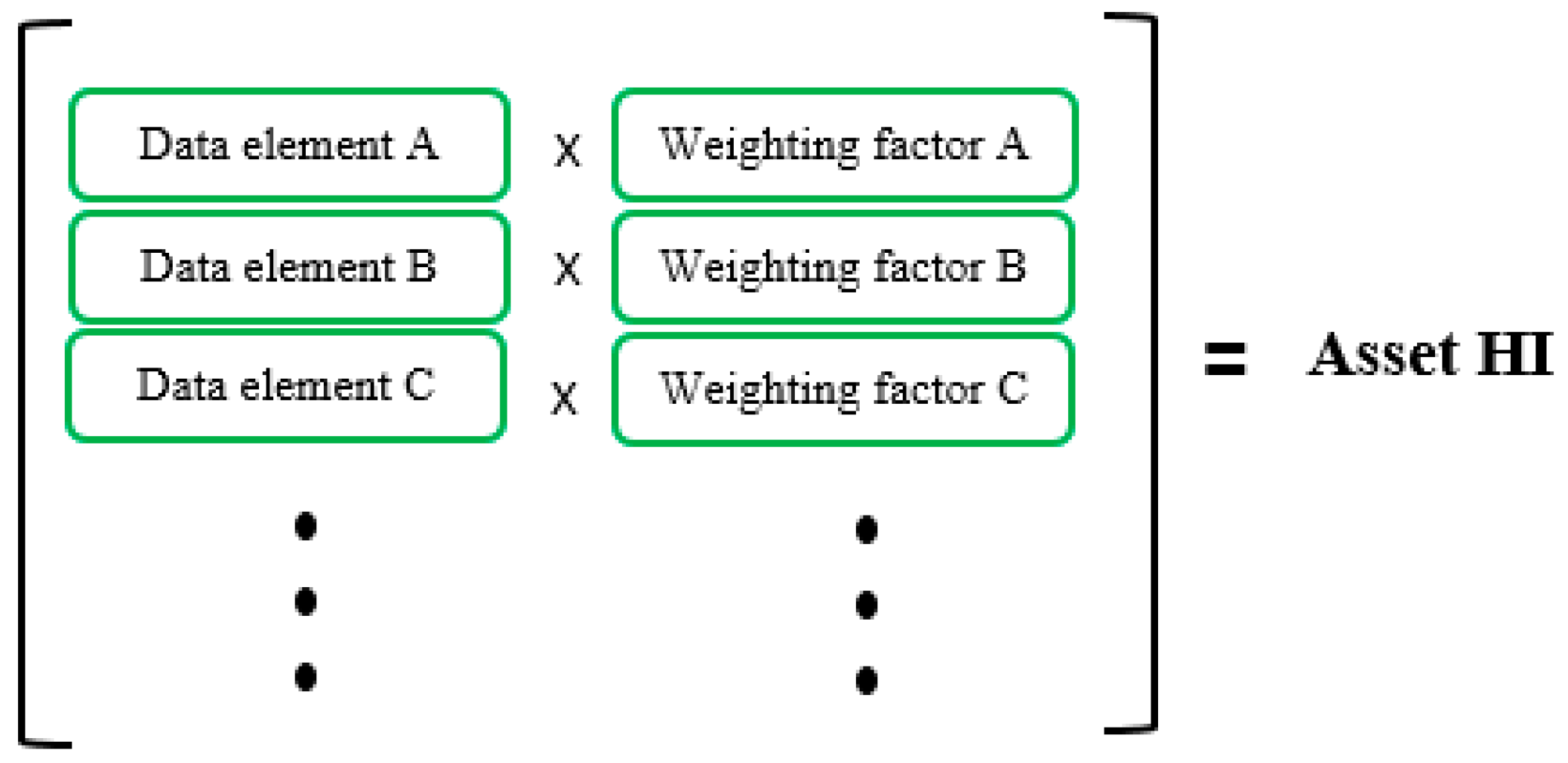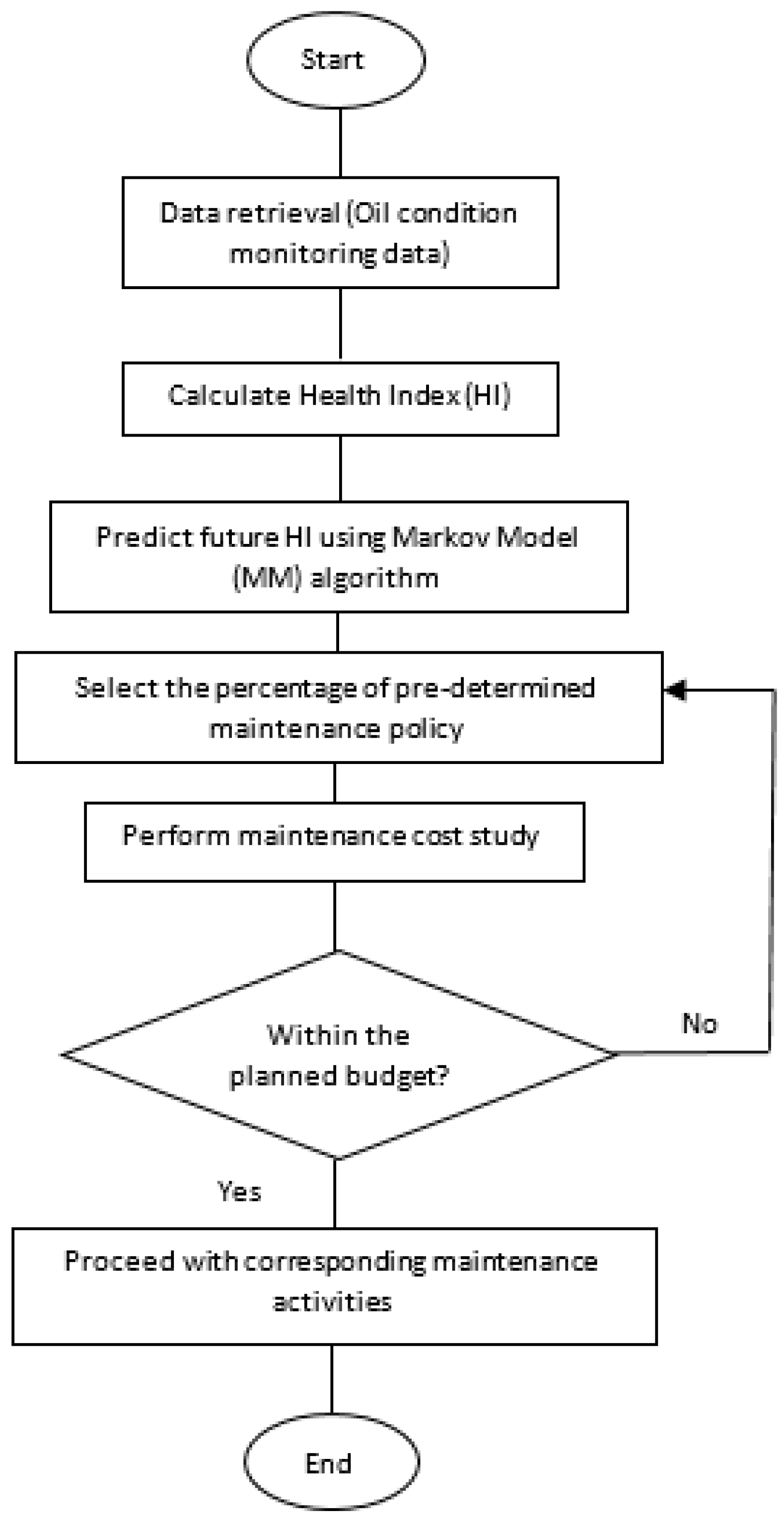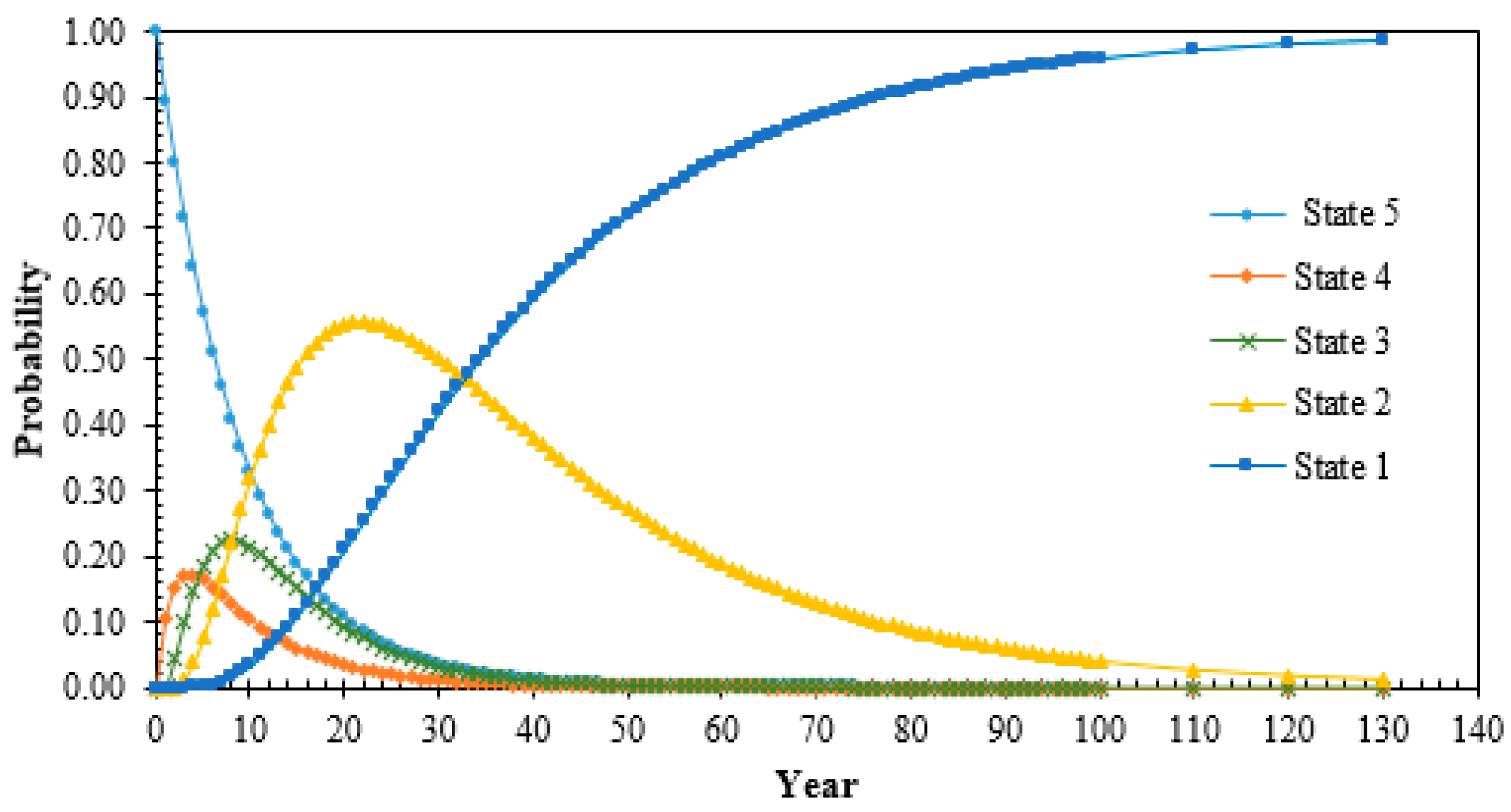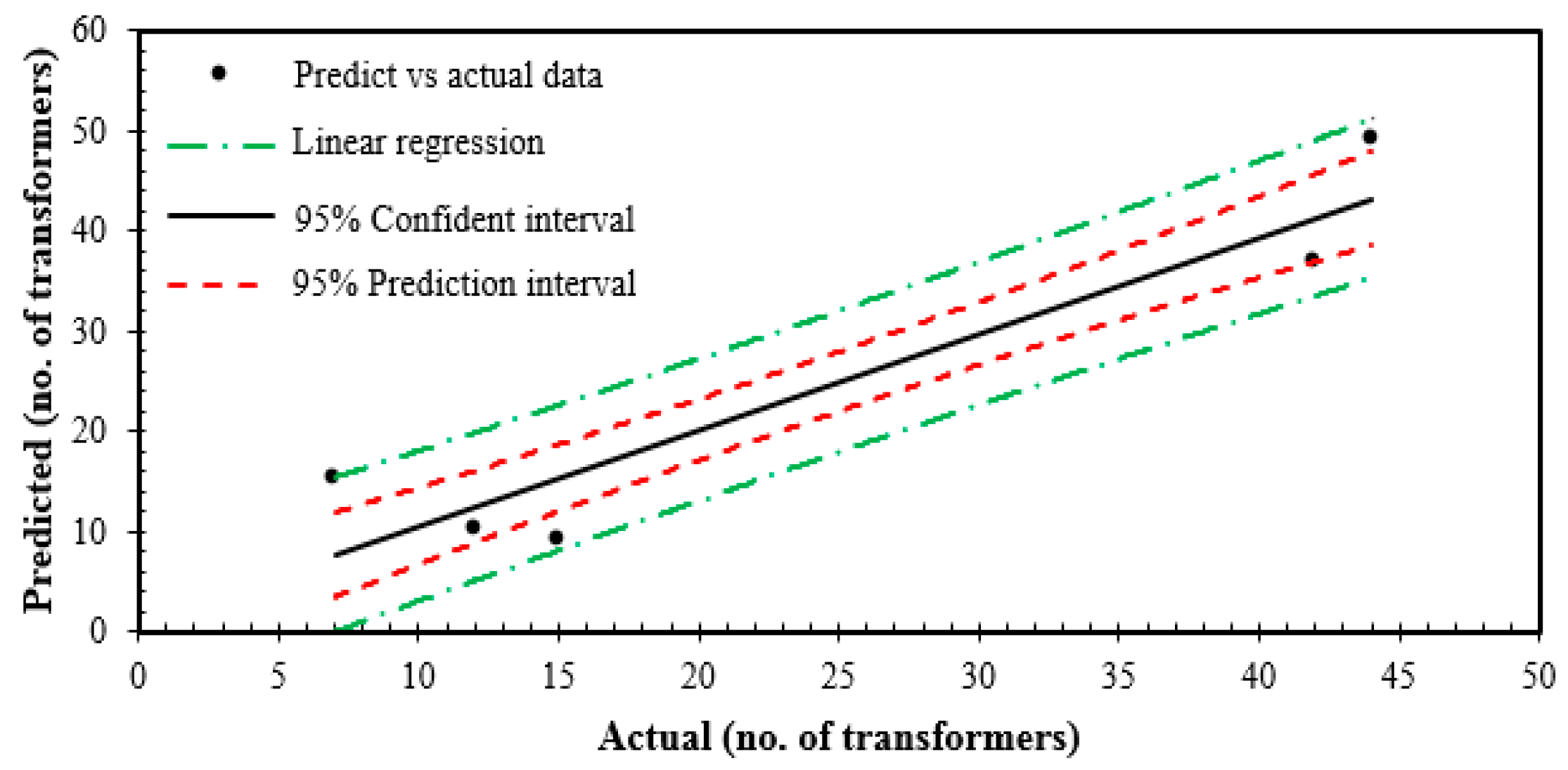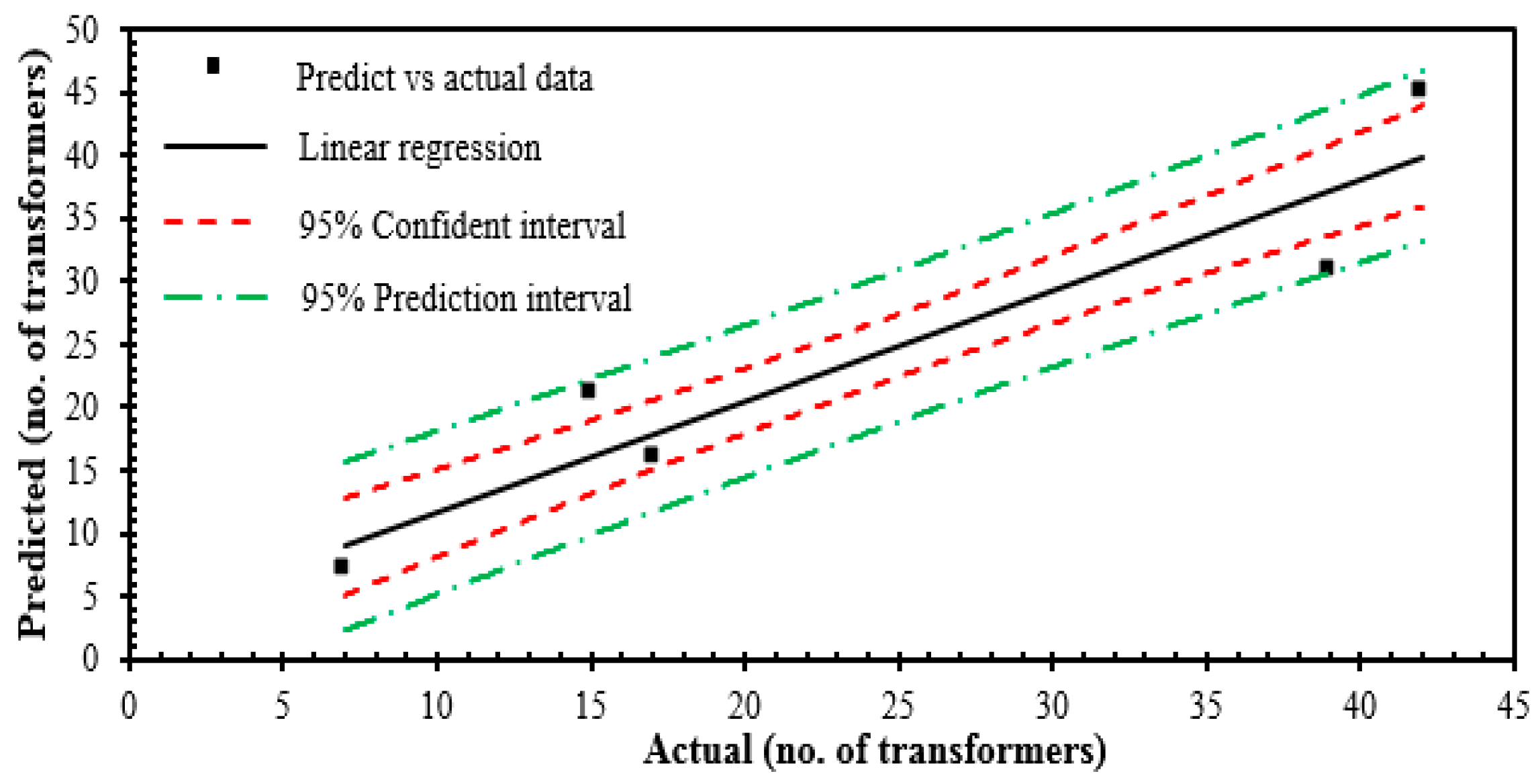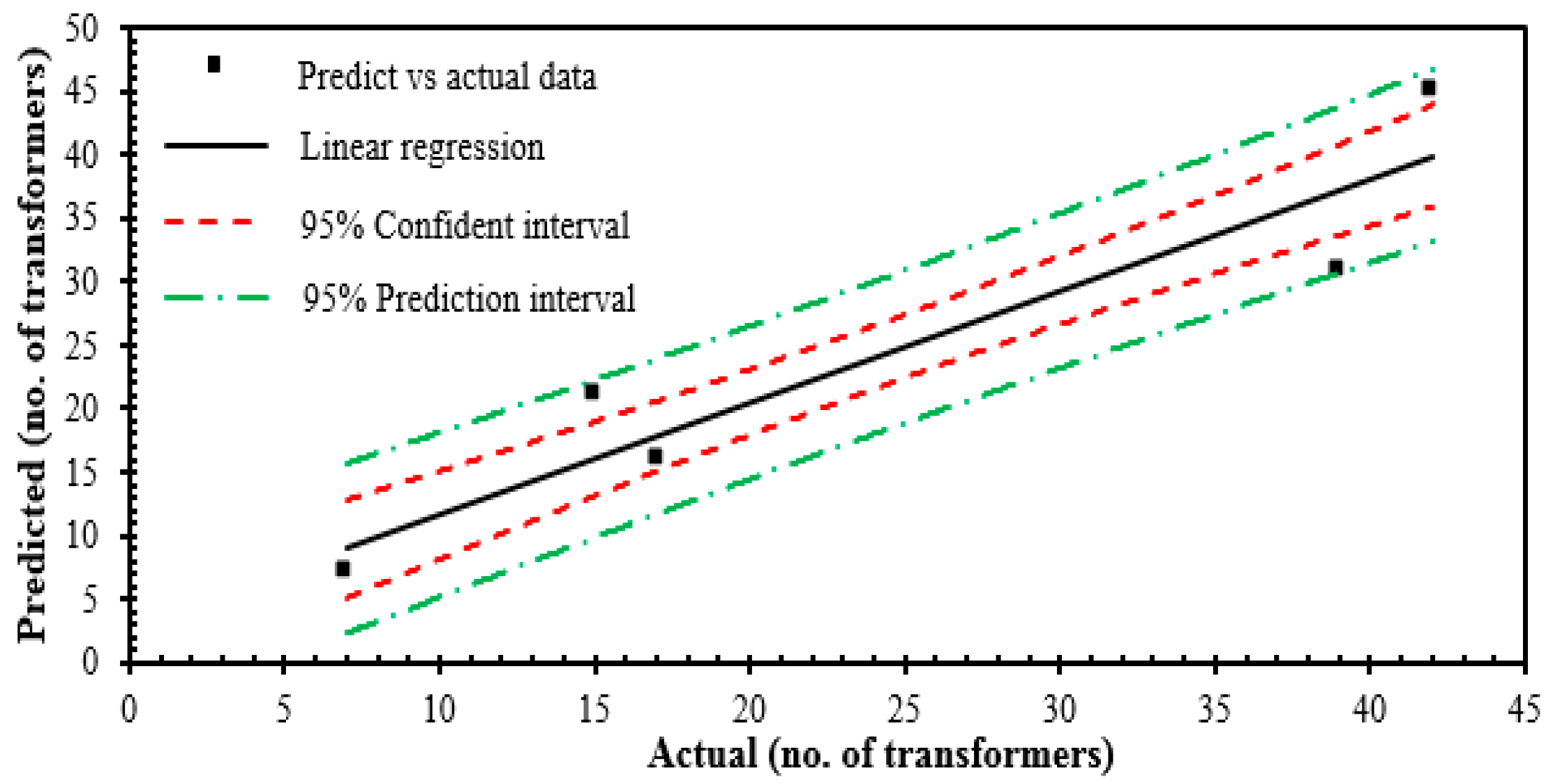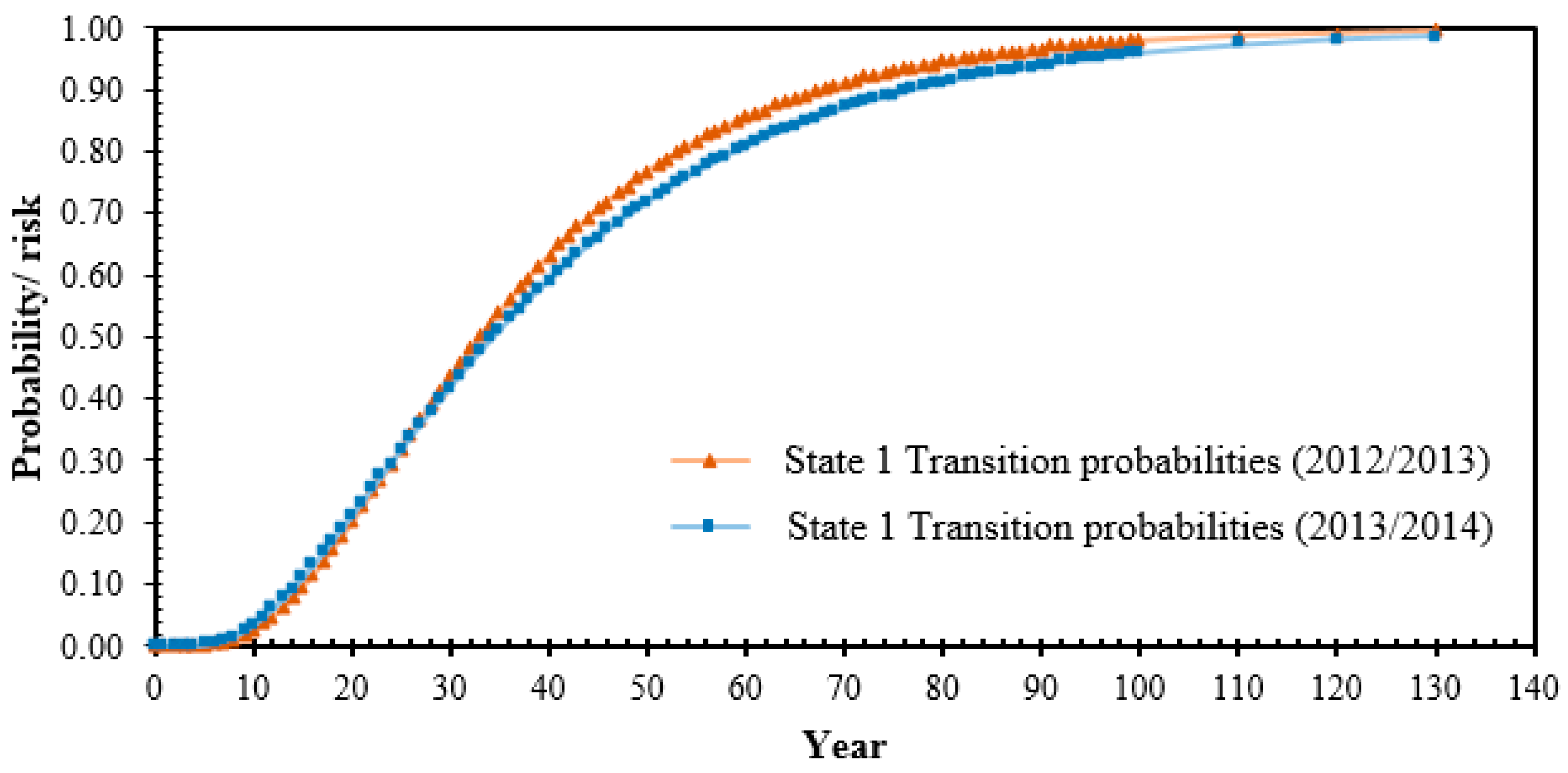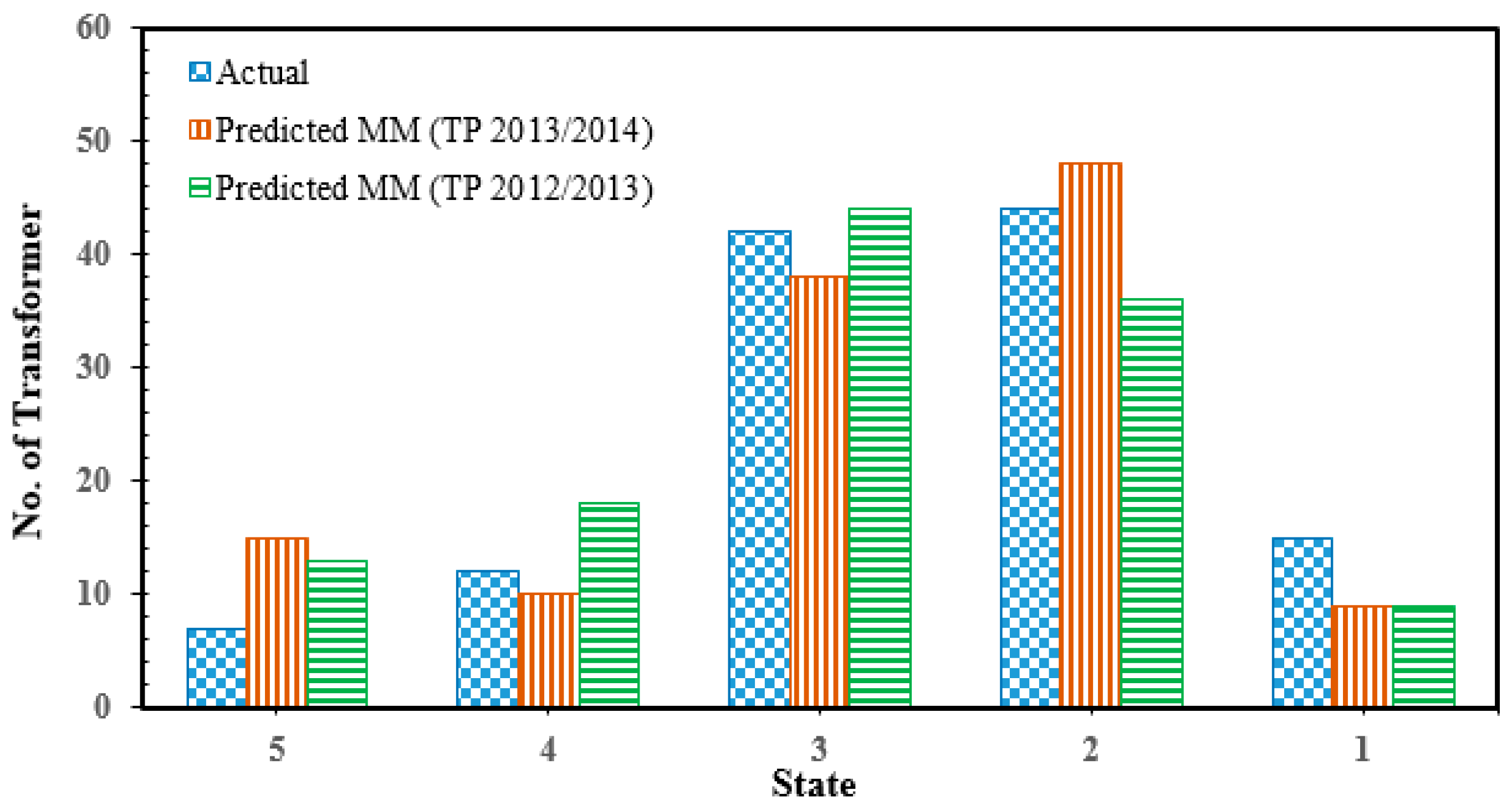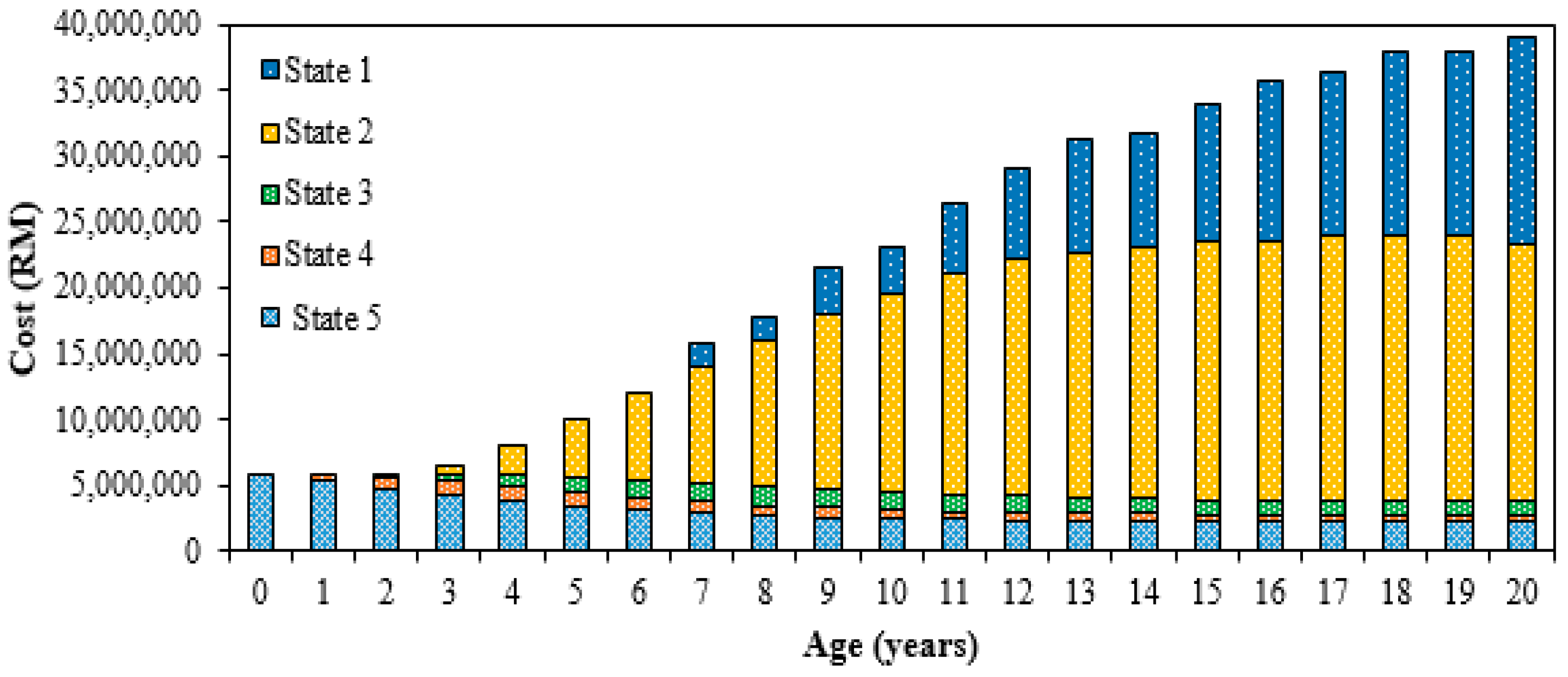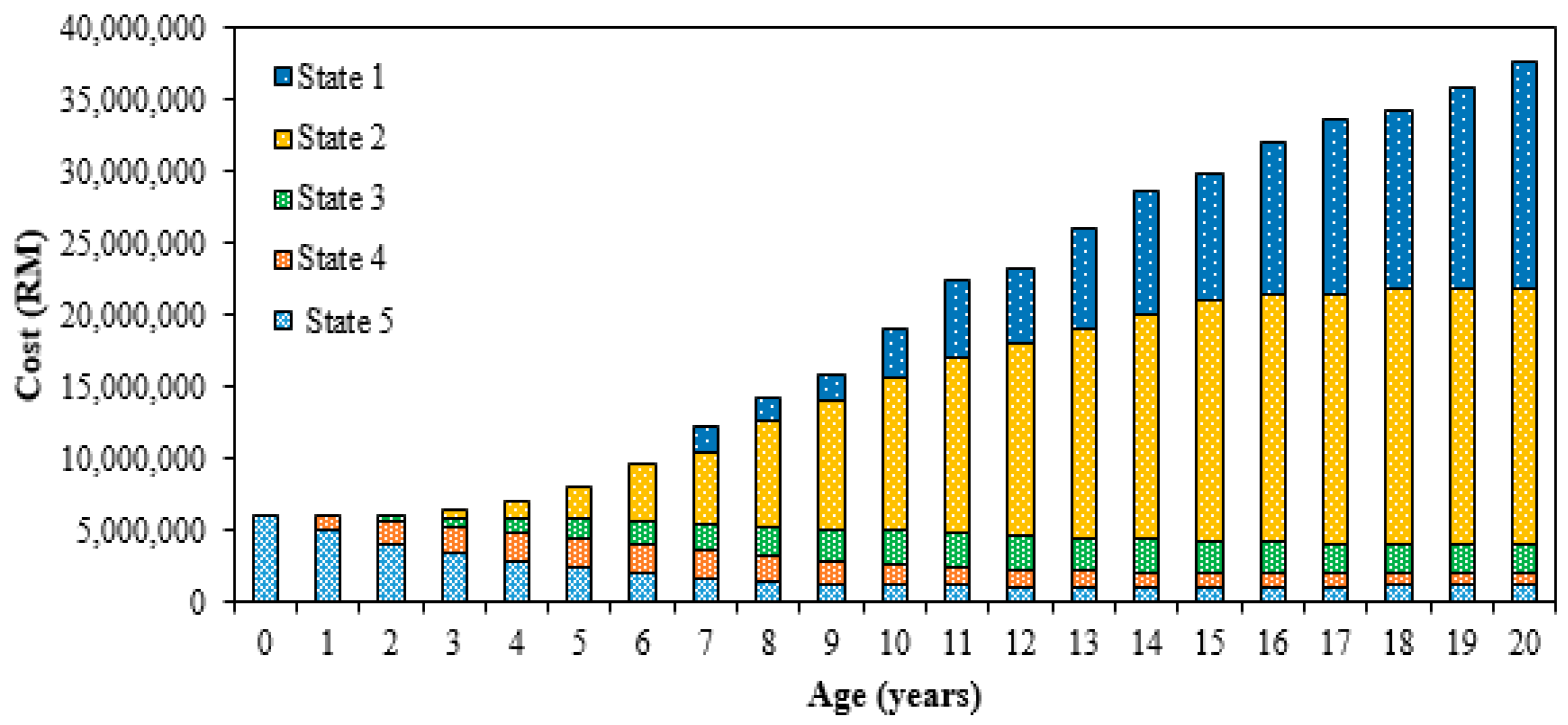1. Introduction
One of the vital elements in power system planning is management of transformer asset. Condition Based Monitoring (CBM) has been introduced by utilities as part of an asset management scheme to monitor the characteristics of operational parameters and provide a comprehensive diagnosis on transformers. Condition trends that indicate abnormality can be detected early and can be used to determine health conditions of transformers [
1].
Multiple condition data are normally considered to diagnose the condition of transformers, such as oil quality, dissolved gases, furanic compounds, power factors, winding resistances, winding ratios, temperature, partial discharges, physical conditions and load tap changer conditions [
2,
3]. This information is embedded in a single quantitative value known as Health Index (HI), which can give overall condition status of transformers [
4,
5,
6,
7,
8]. The HI can be utilized to evaluate transformer deteriorations that require diagnosis, maintenance and approaching end of life [
9,
10].
The HI of transformers has been identified for its potential in predicting the future states of transformer population. Presently, there are fewer studies on modelling the deterioration of transformers using the HI [
11,
12]. A few techniques based on extrapolation, regression, trend forecasting and curve fitting analysis have been implemented to achieve this purpose [
13,
14]. However, due to the scattering nature of HI, a reliable prediction is quite difficult to be achieved based on these techniques [
7,
14,
15].
One of the possible approaches that can be used to evaluate the future condition of transformers is the Markov Model (MM). It is a stochastic approach, where the transition probabilities can be identified based on existing condition data. The MM has been widely applied to forecast the conditions of bridges, bridge elements, pavements, storm water piping components and steel hydraulic structures in civil engineering [
16,
17,
18,
19,
20]. The MM has also been used to predict the deterioration states of switchgear populations, spare units and fault occurrence of transformers [
21,
22,
23,
24]. Based on the MM, the maintenance cost can be estimated to assist asset managers in planning their future budgetary [
25,
26,
27]. The financial aspect of the CBM needs to be planned appropriately whereby it can be achieved by maintenance cost analysis.
In this paper, the MM is applied to predict the deterioration states of the transformer population based on the HI. In total, 120 distribution transformers of oil type (33/11 kV and 30 MVA) are used for the case study. The first part is the modelling of deterioration states of the transformer population based on the MM and the HI. The second part is the sensitivity analysis on the transformer deterioration model based on a pre-determined maintenance policy model. The final part is the assessment of cost impact based on the pre-determined maintenance policy model.
2. Health Index of Transformer
The HI is defined as a method to measure the overall health of an asset by quantifying the condition monitoring information [
28]. It is based on scoring, rating and ranking techniques, which considers theoretical knowledge, standards, guidelines and expert judgments. Most of the electrical power utilities adopt HI for management of transformers, such as Kinectrics Incorporate, DNV KEMA, Hydro Quebec, EDF Energy, TERNA, Electricity Generating Authority of Thailand and Tenaga Nasional Berhad [
6,
7,
8,
29].
Figure 1 shows an example of a basic framework of HI formulation, which is dependent upon the weighting factors in order to determine the final HI [
28].
Equation (1) shows the common HI formulation introduced in [
9,
10], which was adopted in this study:
where
Kj is the assigned rating given for each factor,
HIFj is the assigned score for each factor and
j is the number of condition data. According to [
9,
10], the constant values of
A and
B are 60% and 40%, respectively, which correspond to parameters of transformers and tap changers. In this study, the constants,
A and
B, were not considered since only transformer condition data are available for analysis. Furthermore, due to the limitation of data in the database, only oil quality, dissolved gases and furanic compounds were considered and the updated formulation of HI can be seen in Equation (2):
Based on the HI score, several indicator scales can be determined, which can be seen in
Table 1 [
9,
10,
30].
4. Maintenance Policy and Cost
The maintenance cost is associated with the cost spent for the maintenance actions by utilities to ensure transformers to operate at the optimum level [
35]. Based on the future state probabilities of the transformer model obtained by the MM, the maintenance policy can be determined. The rehabilitation can be modelled by allowing the current state of transformers to return to its preceding state [
25,
26,
27]. A new transition matrix to represent the effect of rehabilitation actions has been introduced in this study, whereby appropriate maintenance approaches were considered, since it was quite difficult to obtain detailed information on the generic maintenance policy model. Based on [
36], there are 3 main maintenance approaches that can be used for transformer operation and maintenance actions known as Condition Assessment (CA), minor work that involves Corrective Maintenance (CM) and major work which consists of refurbishment and replacement. In this study, several assumptions were made for the maintenance policy model. The CA was conducted for transformers in all states. It was performed annually to monitor the transformer condition without improving the condition state. For any transformer at State 2 (poor), CM was carried out to improve the condition to State 5 (very good), while for any transformers in State 1 (very poor), major work was carried out to improve the condition to State 5 (very good). The maintenance actions, intervention states, maintenance activities and estimated cost breakdowns can be seen in
Table 2. The average cost for each maintenance activity from 3 different Original Engineering Manufacturers (OEMs) was used in this study.
Based on the given transition-state probability matrices for the year 2013/2014 and 2012/2013, the future-state probability distribution of the transformer was simulated based on 10% pre-determined maintenance policy model. The matrix of the corresponding maintenance policy model for each of the states,
R, is given by:
The combined effect of the normal deterioration and the maintenance policy model is expressed as
PR [
27]. These Markov chain models were solved to find future-state probabilities at a certain year,
n, by iterating the initial-state distribution matrix with the combined effect of deterioration and maintenance policy matrices, as shown in Equation (15):
Next, the model was evaluated to assess the relative cost impact throughout the life cycle term based on the information in
Table 2. Since each of the state
j is associated with the maintenance cost known as
C, and hence, the expected maintenance cost of each future state for each year,
n, can be determined based on Equation (16):
The overall workflow on the maintenance cost study can be seen in
Figure 3. The model can be updated based on yearly historical data of the transformer population. In this study, the percentage of pre-determined maintenance policy has been determined based on assumptions in order to simulate the cost sensitivity for the maintenance policy. Dependent upon the budgetary, utilities can plan the percentage of the pre-determined maintenance policy in order to optimize the asset management of the transformer population.
5. Application of Markov Model for 33/11 kV Distribution Transformers
In this study, 120 transformers (33/11 kV and 30 MVA) were analyzed for MM. First, the states of all transformers obtained by the MM were defined based on the HI indicator scale in
Table 1. The classification of transformers is tabulated in
Table 3.
Next, the numbers of transformers in its consecutive states were clustered according to its corresponding years, which can be seen in
Table 4.
Since the condition monitoring of transformers was conducted annually, a yearly time period was used as the transition interval. The transformer transition states for the year 2013/2014 and 2012/2013 can be seen on
Table 5 and
Table 6. The transition probability matrices were determined based on the frequency of a transition technique that utilized the transformer transition states for the year 2013/2014 and 2012/2013 and can be seen in Equations (17) and (18) respectively:
Next, the future states of transformers were calculated according to Equation (4).
Figure 4 shows the state probabilities of transformers over the years predicted based on transformer transition states for the year 2013/2014. The number of transformers in its consecutives states can be determined through multiplication with its corresponding probabilities. The probability of State 1 is regarded as a critical state for transformers since the risk of failure is high. Based on this study, it is found that there is a 90% probability that the population of transformer will reach State 1 after 76 years based on the transformer transition states for the year 2013/2014.
The maintenance cost analysis was carried out based on the transition matrices computed from the MM. The future-state distributions were adjusted based on the maintenance policy model that utilized transition states for the year 2013/2014 and Equation (15).
Table 7 shows the distribution of 120 transformers residing in each state for the period of 20 years. The maintenance cost for each of the state distributions was plotted based on Equation (16) and estimated cost defined in
Table 2.
The relationship between the predicted and actual computed numbers of transformers was further analyzed based on a linear regression technique, which can be seen in
Figure 5. The
r2 value of the line fitting was 0.8826. It is found that the data exceeded the confidence interval, but were still within the prediction interval.
An analysis was also carried out based on transformer transition states for the year 2012/2013. A comparison was carried out between the predicted and actual computed numbers of transformers for the year 2014 and 2015, as shown in
Figure 6 and
Figure 7. A similar finding was observed in
Figure 5, where the data exceeded the confidence interval but were still within the prediction interval. For both fittings, the
r2 values were 0.8864 and 0.8619 for the year 2014 and 2015, respectively.
The predicted state probabilities over the years for State 1 in the year 2015 based on transformer transition states for the year 2013/2014 and 2012/2013 are shown in
Figure 8. The percentage of differences for states probabilities for different years were in the range from 0% to 4.87%. Based on the transformer transition states for the year 2012/2013, there is a 90% probability that the population of transformer will reach State 1 after 69 years, which are lower than the prediction based on transformer transition states for the year 2013/2014.
It is apparent that there was a slight deviation between the actual and predicted numbers of transformers for each state, as shown in
Figure 9. Based on transformer transition states for the year 2013/2014, State 5 showed the highest deviation followed by State 1, State 4, State 3 and State 2. On the other hand, State 2 showed the highest deviation followed by State 5, State 4 and State 1 and State 3 based on transformer transition states for the year 2012/2013. For State 2 and State 4, the number of transformers predicted by transformer transition states for the year 2013/2014 is much closer to the actual computed number of transformers than that for the year 2012/2013. It was found that for State 3 and State 5, the number of transformers predicted based on transformer transition states for the year 2012/2013 is closer to the actual computed number of transformers than that for the year 2013/2014. For State 1, the number of transformers predicted based on transformer transition states for the year 2013/2014 is the same as that for the year 2012/2013.
The maintenance cost distribution for transformers in each of the states for transformer transition states for the year 2013/2014 and 2012/2013 can be seen in
Figure 10 and
Figure 11, respectively. The costs in State 2 and State 1 contributed to the highest portion of the maintenance cost. There was no significant increment of the maintenance cost for State 5, State 4 and State 3 over the past 20 years of prediction. The estimated total costs for transformer transition states for the year 2013/2014 and 2012/2013 will gradually increase, as shown in
Figure 12. The estimated total cost for transformer transition states for the year 2013/2014 will increase from RM 5.94 million to RM 39.09. On the other hand, based on the transformer transition states for the year 2012/2013, the maintenance cost will increase up to RM 37.56 million.
